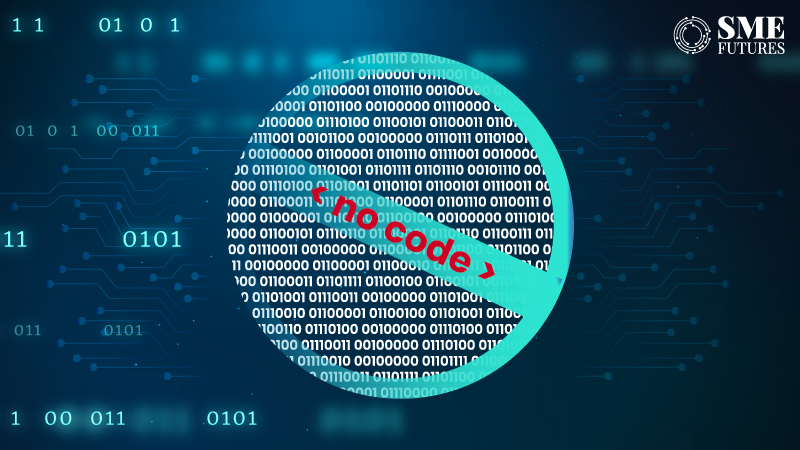We know that coding has always been an integral part of technology, without any exception. But times are changing. And tech evangelists are now talking about no-code.
This is a paradigm shift that puts the power of tech solutions, apps, or even website development in the hands of people like you and me…who have minimal knowledge of how programming works.
Due to this, now a business owner who is an expert in a domain can build a solution according to his needs. The benefits of this scenario are obvious. Also, it is reshaping the way in which a lot of software is being developed. Gartner estimates that by 2023, the number of active citizen developers at large enterprises will be at least four times the number of professional developers. Interesting right?
So, this implies that a person with no technical background can use no-code solutions to create their own website. “That’s correct,” says Muzammil Patel, Global Head, Strategy & Corporate Finance at Acies.
“I would say that creating a website is the lowest form of the use case of no-code. The real sort of utility of no-code is in building enterprise applications, which for the longest time were strictly the domain of large technology companies,” he says.
Also Read: Organisations falling prey to cyber-attacks due to lack of data resiliency
Patel’s five-year-old firm is a no-code platform that powers enterprise-grade applications. According to him, no-code is a significant evolution over what originally was low-code. “It means that everything can be re-used and is not required to be coded every time,” he explains.
Understanding no-code
No-code is not at all like open-source or low code-no code (LCNC).
“People do sort of tend to mix low-code and no-code quite a lot today,” says Patel. But it’s different.
“Open source has been popular for a long time. It’s out there for everyone to use. People may take small frameworks and use them to build with them further. Low-code was originally started as a developer-friendly tool. Along came frameworks like Java and Python, which had certain frameworks like Flask and Django. No-code is a bit of an evolution of those frameworks. In a sense, it is the components that you do not need to code. It’s pre-made and with it you can make an entire web page to configure entire algorithms and visualisations. Overall, everything!” he points out.
So, no-code is a significant evolution over what originally was low-code. “No-code takes that a step further. Well, you don’t actually need to build all the building blocks from scratch. We’ll give it to you on the screen, you can stitch them together however you want to without actually writing any code. So, I think that’s kind of where they are fundamentally different from each other,” says Patel.

Consulting turns into solution making
Patel’s company offers no-code solutions via its proprietary platform, Revolutio. It’s fascinating to learn about how Patel and his team became a no-code service provider. The company actually started out as a consulting firm rather than as a tech solutions provider.
Also Read: Why the rollout of India’s e-rupee is a milestone moment
“It has been an interesting journey. Five years ago, Acies was incepted as a consulting space. But we branched out to focus on the tech space. Instantly, we started building applications. So, with consulting on the side, we started inculcating the knowledge that we gained into apps. In a year and a half, post building quite a few apps, we realised that these will also require maintenance and improvement. And then reality started hitting us a lot harder,” Patel reminisces.
App maintenance means different code bases as different programmers code in different ways. Then it also requires a dependency upon people—which according to Patel was going to be a serious headache for them in terms of opex, time and manpower. So, they started the project with two objectives—to unify the backends and to eliminate coding.
“Our fundamental intent was that since not everyone with domain expertise wants to learn how to code, we wanted to make things easier for them. Which impelled us to start our no-code platform – Revolutio. Eventually, one of our clients suggested that they wanted to build apps by themselves. They said to us that while we use your apps, there are other applications we’d like to build where you don’t have the expertise, but we have the domain skills! And that’s kind of when we started offering Revolutio more broadly to our clients,” says Patel, claiming that since they began offering no-code through Revolutio, he has realised that no-code use cases are limitless.
Also Read: ADIF advocates ‘ease of doing business’ reforms to cut criminal cases against company’s senior execs
His company currently operates within four business verticals, namely-TechWorks, where they have four product families built on Revolutio. Their consulting wing specialises in financial services. LightHouse is their learning and development company, and Ventures is their investment company that helps tech start-ups to grow.
Perceptions are changing
The no-code sector is at a very nascent stage. Having to explain to their clients that they did not need to code was quite challenging for the Acies team. However, Patel believes that while initial disbelief is common, most people have begun to listen to and understand what they are bringing to the table.
“They have gotten used to the evolving technology very quickly. People now understand the concept of no-code. Clients have started appreciating the simplicity of it. However, they still ask a plethora of questions, which is good, and it inspires us to make it more viable for our clients,” he avers.
The pandemic has also provided a thrust to the no-code phenomenon in India. Patel says that more than trust, it was the need for speed that made no-code a viable option for businesses. “During the pandemic, businesses realised that their operations needed to be automated. It also highlighted their dependencies. And I think that all these factors combined together have pushed the need for the adoption of no-code. Obviously, they immediately started recalibrating their traditional IT expenses towards no-code. So most certainly, the pandemic did kickstart the no-code wave,” he says.
Currently, there are a few players in this arena in India and many are still evolving. In terms of competition, the Acies team does not benchmark itself against the domestic players, but it does so with two international players— the Microsoft Power Platform and the New York based Unqork. Bubble.io is another company in the B2C space that they consider as a peer as it has a similar vision and trajectory to them, according to Patel.
The current focus is on MSMEs
Acies currently has a large footprint in India. It also caters to the Middle East and the ASEAN region—very specifically to Singapore, Malaysia, Vietnam and Indonesia. And going ahead, North America has also become an attractive market for them.
Traditionally, Acies is an enterprise player, says Patel. “We have about 80 per cent of our revenues coming from our financial services clients and 20 per cent from the large corporates in the energy, telecom, metals and mining spaces. Which is not good. We have other plans,” he stresses.
Also Read: DPIIT opens startup registration on MAARG portal
Dealing with large corporations and multinational corporations does provide revenue stability and long-term gains. However, change will not occur until the technology is placed in the hands of the MSME sector, according to Patel. As a result, the company’s plan for the coming year is to make their no-code platform accessible to the MSMEs in India.
“Business with large companies really does not democratise technology in the way that we aspire to do, as per our vision. So, our biggest focus area is to make it amenable and simple to use, for small businesses, for business analysts, for those without a technological team, or even for those who want to just plug in and play. We’re still working on several areas such as the drag and drop interface and voice-based engagement with software. Because these are the things which are necessary for increased adoption. In the end, my goal is to give people a portal that empowers them with a link, which can get them started in 10 minutes. I think that’s the bridge that we’re trying to cross to make it a truly democratised platform for MSMEs,” he expounds.
Will it replace the programmers?
Pre-pandemic, Gartner had projected the no-code market to be at roughly about $22 billion, expecting it to grow 20 per cent year-on-year, says Patel. “So, yes, I strongly feel that the scope for no-code is large and continuously growing. I’d say that it has the potential to become at least 40 to 50 per cent of the entire IT/ITeS services market, if not more. Also, as the new tech matures, I expect that at least two to three large players will emerge from India, not just in the services arena but in the product arena as well,” he enthuses.
Many IT service providers today are entirely or partially reliant on coding for any software or application. What will happen is that the reliance on coders will be replaced by a reliance on business analysts who will build apps using no-code platforms.
So does this imply that no-code will replace programmers in the future, we ask.
Also Read: New-age Indian internet firms continue to bleed as startup IPO dream over
“See, you still need programmers to code and there’s definitely a future for coding. However, in my opinion, the volume and velocity at which we have needed coders in the last 10 years, is going to come down dramatically. I mean, programmers need to upskill themselves in the domains that have not evolved too much because of unavailable coding skills. So, coding will migrate upwards. On the other hand, currently, there has been this trend where every parent wants their kid to be a programmer. I think that craze will go away. And coding is no longer going to be a life skill. It’s just something that you can choose to do, as more no-code platforms become mainstream,” Patel replies.
He also feels that it’s going to be an employment generator in this sector. “I think that digitalisation in general will pick up at a massive pace. It’s going to create better paying jobs, new revenue streams and new ways of engaging in commerce. But more importantly, it will sort of put the power to do all of this in the hands of every person, right? It’s no longer going to be something that only Big Tech or the big technology companies can do. I think that will be the biggest transition and it will definitely make a big difference,’ he says as he signs off.











